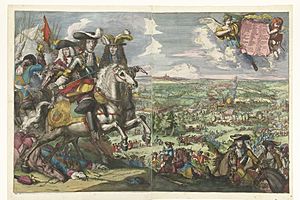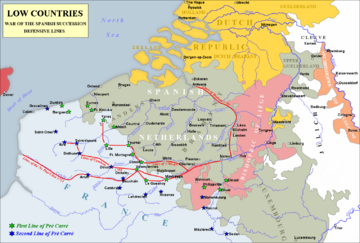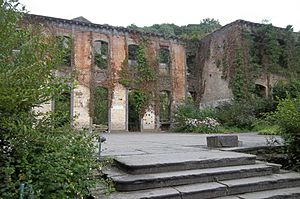Battle of Saint-Denis (1678) facts for kids
Quick facts for kids Battle of Saint-Denis |
|||||||
|---|---|---|---|---|---|---|---|
| Part of the Franco-Dutch War | |||||||
 Battle of Saint-Denis by Romeyn de Hooghe |
|||||||
|
|||||||
| Belligerents | |||||||
| Commanders and leaders | |||||||
| Strength | |||||||
| 40,000-50,000 | 35,000-45,000 | ||||||
| Casualties and losses | |||||||
| 2,500 4,000 |
3,000 4,000 5,000 |
||||||
The Battle of Saint-Denis was the final big battle of the Franco-Dutch War (1672-1678). It happened on August 14, 1678. This was just four days after King Louis XIV of France had agreed to a peace treaty with the Dutch Republic. But he hadn't yet finished peace talks with Spain.
Dutch and Spanish armies started the battle. They wanted to stop the French from taking the town of Mons, which was held by Spain. Mons was near the border of France and the Spanish Netherlands (modern-day Belgium). Both sides said they won, so the result was unclear.
The French commander, Luxembourg, left a small group to continue blocking Mons. He gathered 40,000 to 50,000 soldiers near the villages of Saint-Denis and Casteau. A combined Dutch and Spanish army then attacked them. This army had 35,000 to 45,000 soldiers and was led by William of Orange.
At first, the Dutch and Spanish pushed back the French. They even forced Luxembourg out of his headquarters at the Saint-Denis abbey. But the French fought back hard. Many places changed hands several times. Fighting went on until late evening. William then pulled his troops back to get ready for more fighting. The French still held most of their original positions.
However, the French had lost Saint-Denis itself. This made their position difficult to hold. When the Dutch and Spanish attacked again the next morning, Luxembourg was gone. He had left during the night and stopped blocking Mons. Because of this, Mons stayed under Spanish control. A treaty was signed with Louis XIV on September 17.
Contents
What Led to the Battle
France believed controlling the Spanish Netherlands was very important. It helped with their safety and trade. They took over much of it in the War of Devolution (1667-1668). The Dutch Republic had become independent in 1648. They preferred a weaker Spain as a neighbor, not a strong France.
So, the Dutch-led Triple Alliance made King Louis XIV give back most of his gains. This happened in the 1668 Treaty of Aix-la-Chapelle. After this, Louis decided the best way to get what he wanted from the Dutch was to defeat them first.
The Franco-Dutch War Begins
The Franco-Dutch War started in May 1672. At first, England supported France. French troops quickly took over much of the Netherlands. But by July, the Dutch situation became more stable. Louis XIV made too many demands because he was winning.
Other countries became worried about France's power. The Dutch got help from Brandenburg-Prussia, Emperor Leopold, and Charles II of Spain. In August 1673, an army from the Holy Roman Empire entered the Rhineland. France now had to fight on many fronts. They gave up most of their Dutch gains to focus on other areas. They only kept Grave and Maastricht.
In January 1674, Denmark joined the group against France. In February, England left the war. This happened through the Treaty of Westminster.
Later Years of the War
In early 1674, Louis focused on taking back Franche-Comté. This was finished by the end of June. Then, French troops moved to Condé's army in the Spanish Netherlands. Both sides lost many soldiers in the Battle of Seneffe on August 11. This battle made Louis prefer fighting with sieges and careful troop movements.
Peace talks started in Nijmegen in 1676. These talks became more urgent in November 1677. This was when William of Orange married his cousin Mary. She was the niece of Charles II of England. An alliance between England and the Dutch followed in March 1678. But English troops didn't arrive in large numbers until late May.
This delay allowed Louis to improve his position for the peace talks. He captured Ypres and Ghent in early March. Then, he signed a peace treaty with the Dutch on August 10.
The Battle of Saint-Denis

French war plans were based on Vauban's "pré carré" idea. This was a double line of fortresses to protect France's northern borders. You can see it on the map. Mons was the most important place still held by the Spanish. Even though the Dutch had agreed to peace, Spain had not. This gave France a chance to capture Mons.
In March, a French force under de Montal blocked Mons. They were based at Saint-Ghislain and Marville. In late June, Louis told Luxembourg to continue blocking Mons. But he also said to stay on defense and move most troops back to the French border.
However, the Allies kept trying to help Mons. So, Louis finally let Luxembourg fight a battle. He hoped to cause enough losses to force the Dutch to make peace.
Armies Prepare for Battle
On August 12, Luxembourg's army of 40,000-50,000 soldiers camped near Saint-Denis and Casteau. A combined Dutch and Spanish force of 35,000-45,000 was at Soignies. This was about a three-hour march away.
William and Villahermosa knew the Dutch were close to peace. But they decided to attack anyway. The war with Spain was still going on. Stopping Mons from falling would help both of them. Luxembourg was at the Abbey de St Denis. This was an important spot in front of the French right side. Some say he learned the treaty was signed that morning. But historians disagree if either side knew peace was formally agreed.
Luxembourg thought his position was strong. He didn't expect William to attack. His scouts also told him the same. He believed the Allies wanted to attack the French siege works across the Haine River. He thought any attack on his lines would just be a distraction. So, when Dutch soldiers called dragoons took over the woods around Saint-Denis, Luxembourg did nothing.
The Fighting Begins
By 2:00 PM, the Allied troops were ready. William ordered attacks on both the French left and right sides at the same time. Villeroy was in charge of Saint-Denis. He reported that the Allies were moving towards the Abbey. Luxembourg ordered his cannons and supplies to move back.
Around 3:00 PM, Dutch troops led by Count Waldeck captured the Abbey. They suffered many losses. William's secretary later wrote that 300 to 400 bodies were on the ground. The Dutch pushed the French back to a creek on the battlefield. But the Allies could not cross the creek and break Villeroy's main line. At the same time, Spanish and Dutch foot soldiers attacked Casteau. They took most of the village.
Luxembourg then realized this was a real attack. He sent his reserve troops to fight for Casteau. This battle lasted over five hours. The church, mill, and chateau in the village changed hands many times. Both sides had many casualties in fierce hand-to-hand combat. Luxembourg was wounded. William was reportedly saved by Hendrik Overkirk. Overkirk killed a French dragoon who was close to William.
Around 7:00 PM, William told his soldiers in Casteau to pull back. Spanish cavalry and a small group stayed behind to cover them. Then they also pulled back. Only a regiment of French Huguenots (French Protestants who were exiled) stayed in the chateau. They fought until they were defeated just after 9:00 PM. By then, it was completely dark. Even at Saint-Denis, where neither side gained more ground, the fighting stopped around 10:00 PM.
The French had about 4,000 soldiers killed or wounded. This included 689 from the special Gardes Francaises unit. The Allies had similar or slightly higher losses, around 5,000 in total. Other reports say French losses were about 2,500, and Allied losses were about 3,000. The only British troops were six regiments of the Dutch Scots Brigade. Their commander, the Earl of Ossory, lost about 25% of his officers.
Most French losses were from the thirteen infantry regiments fighting around Casteau and Saint-Denis. Their fighting power was greatly reduced. More importantly, the French could not take back Saint-Denis. This meant their positions were no longer safe. Their connection to the troops blocking Mons was in danger. So, Luxembourg decided not to wait for another attack.
Around 11:00 PM, Luxembourg ordered his troops to cross the Hain River behind them. They destroyed the bridges. Then they rejoined the force blocking Mons. The Allies didn't find out until the next morning. Luxembourg's quick retreat meant he left behind his wounded soldiers and some supplies.
What Happened Next
Like many battles back then, both sides said they won. Luxembourg claimed victory because he had stopped the Allied attacks. He also said he had fewer losses and kept most of his original positions. William, however, said he only pulled his troops back to get ready for another attack. When they attacked again on the morning of August 15, the French were gone.
Both sides had reasons for their claims. But the immediate result was that William continued his march towards Mons. He did this after the bridges were fixed. When he arrived, Luxembourg had already stopped blocking Mons and retreated. This meant the Allies achieved their goal: Mons stayed under Spanish control. Because of this, the battle's outcome is still debated. Some call it a French victory, others a narrow Allied defeat, or even an Allied victory.
Spain and France agreed to a ceasefire on August 19. A formal peace treaty was signed on September 17. France gave back Charleroi, Ghent, and other towns in the Spanish Netherlands. But Spain gave up Ypres, Maubeuge, Câteau-Cambrésis, Valenciennes, Saint-Omer and Cassel. Except for Ypres, all these towns are still part of modern France.
Images for kids
-
Vauban's pré carré line of fortresses. Green shows the first line, blue the second line.
-
Hendrik Overkirk saves William of Orange from a French dragoon, by Jacob de Vos









